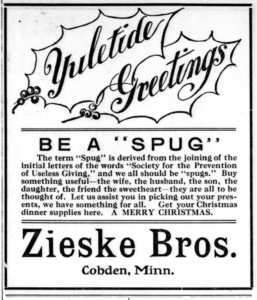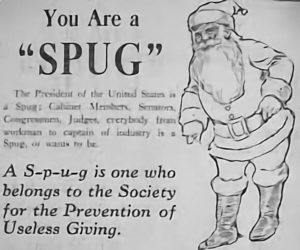Small Home Gazette, Fall 2022
Think the Holidays Are Too Commercial?
So Did the Arts & Crafts Movement—a Century Ago
This article was originally published in the blog of the Minneapolis Institute of Art in December 2017. Reprinted with permission.
Is all the pressure to buy, buy, buy during the winter holidays—early in the morning, late at night, 24/7 on the internet—turning you into the Grinch? Would you rather craft your own gifts than touch the latest plastic gewgaws with a 39 ½-foot pole? Would you rather just send a card?
You would have made a fine SPUG—a member of the Society for the Prevention of Useless Giving, formed to combat the rising tide of compulsory gift-giving, way back in 1912. The expectation then, even more than now, was to heap gifts onto every friend, coworker and acquaintance. This exercise in excess was made almost too easy by the availability of cheap, industrially made, and admittedly useless “gimcracks,” like gaudy figurines, cheap paintings, and poor-quality jewelry.
The progressive backlash against this rampant consumerism included a Shop Early Campaign encouraging shoppers to hit the stores well before the advertising-induced last-minute rush and only during regular shopping hours. This discouraged extended holiday hours that ruined the season for everyone, not least the store employees. Sound familiar?

Unsurprisingly, commercial retailers jumped on the SPUG bandwagon, proclaiming that their high-quality goods were truly worthy of gift-giving. This ad ran in the December 24, 1915, edition of the Sleepy Eye Herald-Dispatch in Sleepy Eye, Minnesota. Image courtesy of the Minnesota Historical Society.
A New York Times article from 1913 about a Manhattan rally of SPUGSs describes the movement’s popularity as “a vigorous protest against the growing custom of exchanging gifts at Christmas without sentiment” and its members as a silent majority “who in his or her heart, had been bitterly resenting the annual hold-ups under the disguise of the Christmas spirit.”
Proponents of the Arts & Crafts movement in the United States linked its philosophy to gift-giving. The Craftsman, an Arts & Crafts magazine published by Gustav Stickley, ran an article called “The Christmas Present Problem,” which stated, “We want to give something that is distinctly individualistic…something that is so intrinsically beautiful it will always remain an object of value to the friend.”
This led to the sale of what were called “halfways,” such as linen purses printed with a pattern that was hand-embroidered by the gift-giver in the popular Arts & Crafts style.
The Handicraft Guild of Minneapolis had a shop downtown at the time and was a prime source for local ceramics, jewelry, leatherwork, and other Arts & Crafts objects made by artists on the premises.
Christmas cards, very popular by the 1910s, were also pushed as personalized alternatives to cheap gifts. And though few of us can leave it at that today, rest assured there is plenty of precedent for a less-is-more holiday.
The SPUGs are on your side.














